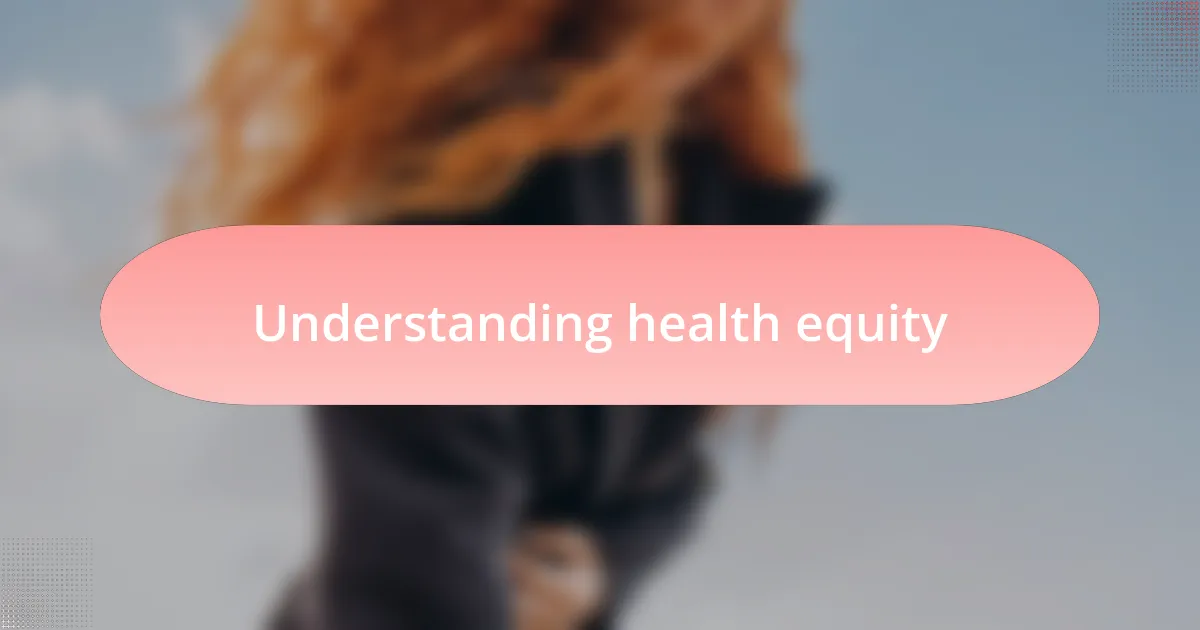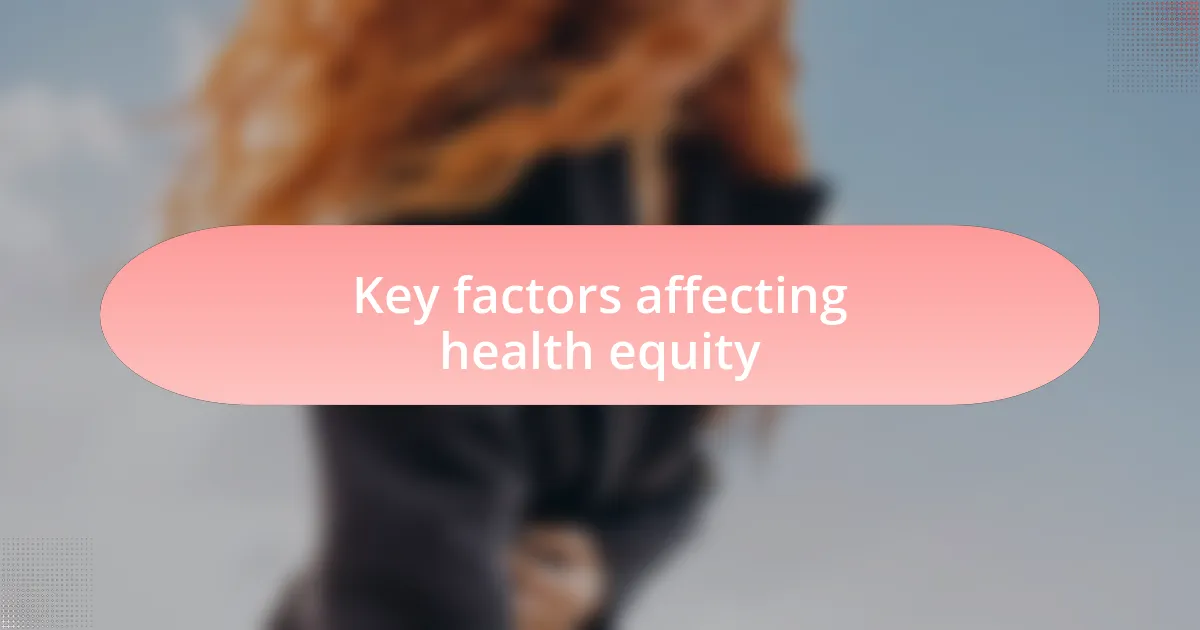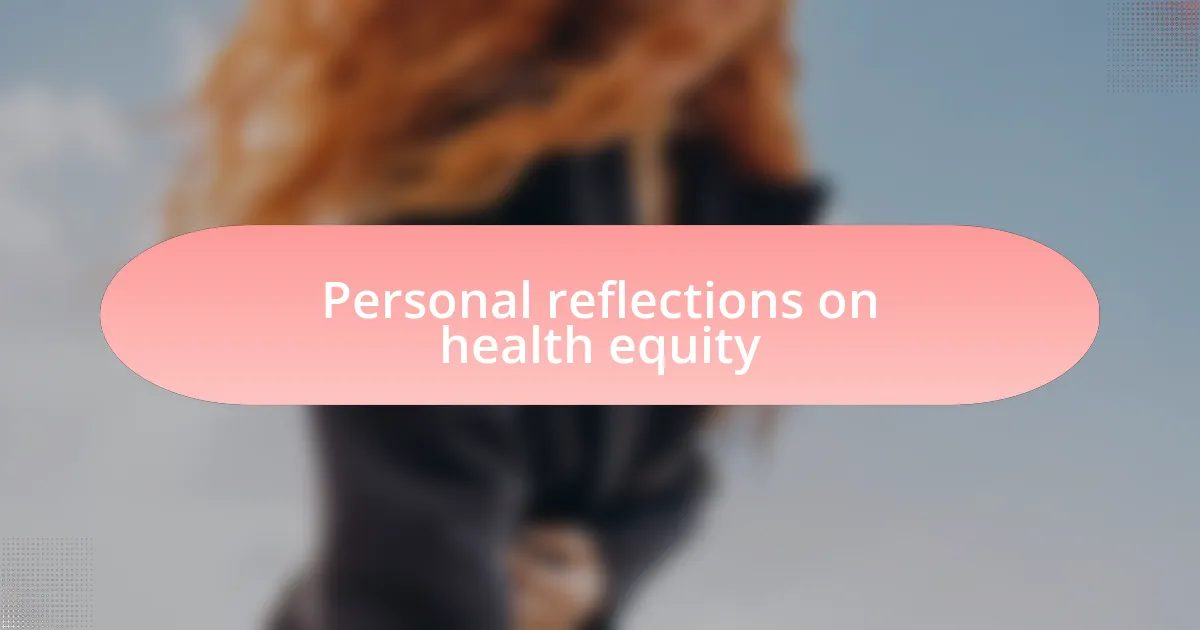Key takeaways:
- Health equity requires addressing socioeconomic factors, education, and systemic inequalities that affect access to healthcare.
- Challenges include transportation issues, cultural and language barriers, and the stigma surrounding certain health conditions.
- Personal experiences highlight the emotional toll of health inequity and the importance of navigating the healthcare system effectively.
- Strategies for promoting health equity include community health programs, culturally competent care, and advocating for policy reforms addressing social determinants of health.

Understanding health equity
Health equity means ensuring that everyone has the fair opportunity to be as healthy as possible. It goes beyond just access to healthcare; I often think about how a person’s environment, economic status, and social connections deeply influence their health outcomes. Have you ever noticed how certain communities face more significant health challenges simply because of where they live or how much they earn?
In my experience, discussing health equity reveals stark differences in public health access. For instance, I once volunteered at a community clinic and saw firsthand how disparities in education and income could determine the level of care people received. It was heartbreaking to witness individuals struggle to access even basic preventative services just because they lacked transportation or insurance, emphasizing that health equity is not just a statistic—it’s a matter of real lives affected by systemic inequities.
When I think about health equity, I can’t help but feel a sense of urgency to address these disparities. Consider this question: How can we close the gap in healthcare access that seems to persist across generations? My belief is that we must advocate for policies that prioritize underrepresented and underserved populations, creating a foundation where everyone, regardless of their background, has the chance to thrive.

Key factors affecting health equity
One key factor affecting health equity is socioeconomic status. From my observations, individuals with lower incomes often grapple with multiple barriers, such as limited access to nutritious food and inadequate housing. I recall a friend who, despite working multiple jobs, was unable to afford healthy meals. This made me wonder: how is it fair that a person’s paycheck can dictate their health options?
Another significant factor is education. I’ve seen how health literacy—or the lack thereof—can drastically impact one’s ability to make informed health choices. I once attended a health workshop in a low-income neighborhood where many participants seemed unaware of basic health guidelines. It struck me profoundly that knowledge is a privilege in these contexts; without education, how can we expect individuals to navigate their health effectively?
Lastly, I can’t overlook the role of systemic inequalities, such as racism or discrimination in healthcare settings. When I hear stories from friends who faced prejudice while seeking care, it reinforces my belief that many people simply don’t receive the treatment they deserve. How often do we hear about someone being treated differently because of their background? This isn’t just about health; it touches on the very fabric of our society.

Challenges in achieving health equity
Achieving health equity is fraught with challenges that often feel insurmountable. For example, I remember a community health event I attended where the main topic was access to care. Despite having a well-structured plan to provide services for those in need, many attendees still faced transportation issues. Isn’t it disheartening to think that a lack of reliable public transport can prevent someone from accessing even basic medical services?
Another hurdle lies within cultural and language barriers. I once volunteered at a clinic where I met a patient who struggled to communicate her symptoms because of language differences. This made me realize how essential it is for healthcare providers to offer services that resonate with diverse communities. How many patients, I wondered, are left without adequate care simply because they can’t voice their needs?
Lastly, let’s consider the deep-rooted stigma that surrounds certain health conditions, particularly mental health. I’ve had conversations with individuals who were reluctant to seek help due to the fear of judgment. It’s a stark reminder that stigma can create invisible walls that further marginalize already vulnerable populations. In a society that strives for equity, isn’t it our responsibility to dismantle these barriers?

Personal reflections on health equity
When I think about health equity, I can’t help but recall the time I accompanied a friend who was seeking treatment for a chronic illness. She was nervous and overwhelmed by the medical jargon, and I found myself wondering how many people feel lost in the healthcare system without someone to guide them. It struck me that health equity isn’t just about access; it’s also about understanding and navigating the complexities of care.
I often reflect on the economic disparities that shape our health outcomes. A few years ago, I spoke with a mother who juggled multiple jobs to make ends meet, all while trying to care for her ailing child. It was heartbreaking to see her overwhelmed by the pressure to provide, which often meant sacrificing her own health. How can we claim to have a fair system when economic status dictates the quality of care one receives?
The emotional toll of health inequity is something I’ve seen firsthand. A close family member faced numerous hurdles in accessing necessary treatments due to their socioeconomic status. Their frustration and helplessness left a mark on me, leading me to ask: What does it mean to live in a society that fails to prioritize health for all? It’s these personal experiences that keep me motivated to advocate for systemic changes that embrace true equality in health.

Strategies for promoting health equity
One effective strategy for promoting health equity is the establishment of community health programs that focus on education and resource availability. I recall attending a health fair that aimed specifically at underserved populations. It was inspiring to witness how accessible screenings and educational workshops empowered individuals to take charge of their health; they left with knowledge and resources that many had never encountered before. It made me wonder why such initiatives aren’t more widespread.
Another approach is the incorporation of culturally competent care in healthcare settings. I remember hearing stories from a colleague about how language barriers created significant healthcare delays for immigrant families. It sparked a realization in me: when providers make an effort to understand cultural contexts and communicate effectively, health outcomes improve dramatically. Isn’t it crucial that we ensure everyone feels seen and understood in their healthcare journey?
Advocating for policy reforms that address social determinants of health is equally essential. I once attended a local town hall meeting where residents voiced their concerns about the lack of affordable housing and its impact on health. Listening to their stories, I felt a strong connection to the idea that health equity cannot be achieved without addressing the underlying factors that shape our lives. How can we expect individuals to thrive health-wise when they’re burdened by such critical challenges? This intersectionality of issues is why a multi-faceted approach is crucial for true health equity.